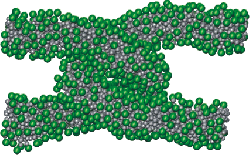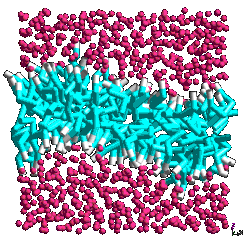In our simulations we employ fully atomistic models,
as well as coarse grained models in which a lipid is reduced to
a small number of hydrophilic (head) and hydrophobic (tail) particles.
We studied the mechanical properties of these bilayers,
i.e. the
,
and showed that undulations have a significant effect
on the apparent elasticities reported
in the simulation literature [
].
By exposing the membrane to shear flows
with perpendicular and parallel orientations,
we were able to calculate
the
].
The surface viscosity was found to be related to
the lateral diffusion coefficient of the lipids [
],
while the friction coefficient determines the relaxation rates
of thermal undulations with short wave lengths [
].
We also studied the influences of lipid architecture and surface tension
on the dynamics.
The first
line tension or edge energy coefficient
was obtained from the average radii of stable pores in stretched membranes,
yielding values in good agreement with experimental data [
5].
Interestingly,
we derived that
a stable pore requires a minimum elongation that
scales with the number of lipids to the power -1/3,
explaining the marked difference in elongations between
experimental (~2%) and simulation (~35%) studies of pores.
We developed a constraint technique
to smoothly open and close a pore
in a fully controlled and reversible fashion,
allowing us to calculate the
free energy profile
of the pore formation process [
6].
By simulating a bilayer of ceramide-2,
the main lipid in the nearly impermeable upper layer of the
human skin,
we established that the potent
penetration enhancer dimethylsulfide (DMSO)
undermines the skin's barrier function
by inducing a phase transition in the membrane [
7],
as well as drastically lowering the line tension of pores [
8].
worm-like micelles

By tuning the parameters of a coarse grained model,
we performed the first simulation of a stable wormlike micelle [
9],
yielding a bending rigidity and persistence length
at the lower end of the experimental range.
An interesting
buckling transition is observed,
in worms and bilayers alike,
if the compressive stress exceeds Euler's force.
When a solution of wormlike micelles is sheared,
the worms easily get hooked behind one-another
and a tension builds up in the worms until they yield.
We simulated entanglements of two worms,
see picture,
and observed that the tension eventually leads -- contrary to previous conceptions --
to the
merging of the worms
and the formation of two Y-
junctions [
10].
The entangled worms never broke up.
One readily envisages how the merging of worms,
and the easy dynamics of junctions,
explains the
shear thinning flow behaviour
observed in many of these systems.


 By tuning the parameters of a coarse grained model,
we performed the first simulation of a stable wormlike micelle [
By tuning the parameters of a coarse grained model,
we performed the first simulation of a stable wormlike micelle [